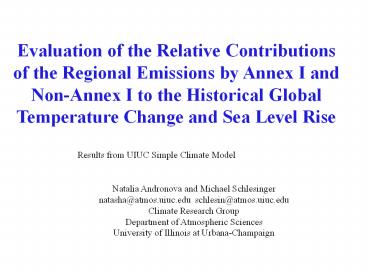Results from UIUC Simple Climate Model PowerPoint PPT Presentation
1 / 13
Title: Results from UIUC Simple Climate Model
1
Evaluation of the Relative Contributions of the
Regional Emissions by Annex I and Non-Annex I to
the Historical Global Temperature Change and Sea
Level Rise
Results from UIUC Simple Climate Model
Natalia Andronova and Michael Schlesinger natasha_at_
atmos.uiuc.edu schlesin_at_atmos.uiuc.edu Climate
Research Group Department of Atmospheric
Sciences University of Illinois at
Urbana-Champaign
2
Phase 1 - Initial check HadCM3 climate
model 4xCO2 A2 future emissions
scenario Timeframe 1760 to 2100
3
4
5
Phase 2 - Sensitivity study four country
groups OECD in 1990 (OECD) Eastern Europe and
former Soviet Union (REF) Asia (ASIA) Africa
and Latin America (ALM) Timeframe Emissions
start dates 1890 Emission end dates 2000
The time for which the attribution calculations
will be performed 1980, 1990,
2000
6
Model parameters Emissions Historical
EDGAR database (1.3) (http//www.rivm.nl/env/in
t/coredata/edgar/) Future A2 emission
scenario from the IPCC SRES Emissions to
Concentrations Schlesinger, M. E. and S.
Malyshev (2002) Changes in Near-Surface
Temperature and Sea Level for the Post-SRES
CO2-Stabilization Scenarios. Integrated
Assessment, 2(3), 95-199. Concentrations to
radiative forcing as in the IPCC TAR.
7
temperature change or sea level rise
over regions
over gases
8
Global mean temperature change
Case 1 the cumulative emissions for all species
Case 2 the cumulative emissions for
GHG instantaneous for sulfates
Case 3 the cumulative emissions for
CO2N2O instantaneous for CH4sulfates
9
ALM
10
(No Transcript)
11
SEA LEVEL RISE
Case 1 the cumulative emissions for all species
Case 2 the cumulative emissions for
GHG instantaneous for sulfates
Case 3 the cumulative emissions for
CO2N2O instantaneous for CH4sulfates
12
Conclusions
A cooling effect of the sulfate aerosol is highly
important
13
Recommendations
should be included in the analysis
other aerosols, such as those due to biomass
burning and fossil fuels
other greenhouse gases, such as the
chlorofluorocarbons and tropospheric ozone
different databases for the historical emissions.
to calibrate the simple climate model
to use other coupled GCMs, with different
climate sensitivities and different oceanic heat
uptakes

